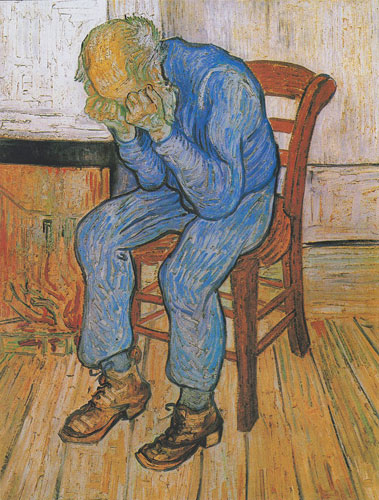Read in English / 阅读语言 ไทย
![]() 简体中文
简体中文

Artwork Title: Sorrowing Old Man (At Eternity’s Gate)
Artist: Vincent Van Gogh
Year of Completion: May 1890
Exhibition Location: Kröller-Müller Museum
Technique: Oil on canvas
Dimensions: 80 cm × 64 cm
The Painting “Sorrowing Old Man (At Eternity’s Gate)” by Van Gogh is considered a masterpiece, bearing his signature style. Today, let Tae Art Man tell you a story of this oeuvre.
Painted just 2 months before his death
The painting Sorrowing Old Man (At Eternity’s Gate) is a powerful work by Van Gogh, reflecting his profound melancholy and transforming it into a beautiful piece of art in his own style. The artwork measures approximately 80 x 60 cm. Van Gogh painted this piece just two months before his death. Towards the end of his life, Van Gogh underwent several treatments for his mental health, especially after Gauguin left him two years prior (resulting in the incident where he cut off his ear). It is believed that he created this painting while staying at the Saint-Paul-de-Mausole asylum in Saint-Rémy-de-Provence.
Inspiration from the image of retired soldiers in the hospital
One might assume that Van Gogh painted this image from his own emotional suffering at that time, but that is not entirely true. Van Gogh had been interested in portraying the seated figure with a downcast face for a long time. Going back eight years before his death, he saw the painting Sunday At Chelsea Hospital by Sir Hubert von Herkomer, an English artist of German origin. The painting depicted the melancholy of retired soldiers waiting at the hospital on a Sunday morning.
The grimness hidden by Sir Hubert was conveyed through the rows of seated figures, appearing dejected and lifeless, to the point where one couldn’t tell if they were alive or dead. Nearby individuals had to check their pulse to make sure they were still alive.
The iconic pose of Van Gogh’s models
Van Gogh was deeply impressed by this kind of profound melancholy and had studied and attempted to depict this pose in various lithographs and line drawings before creating it as an oil painting, which is the artwork we see now. That’s a brief background story of this painting. Another interesting aspect is that this pose with hands on the face is found in many of Van Gogh’s other works, spanning different subjects and periods. It can be considered one of Vincent Van Gogh’s signature poses.